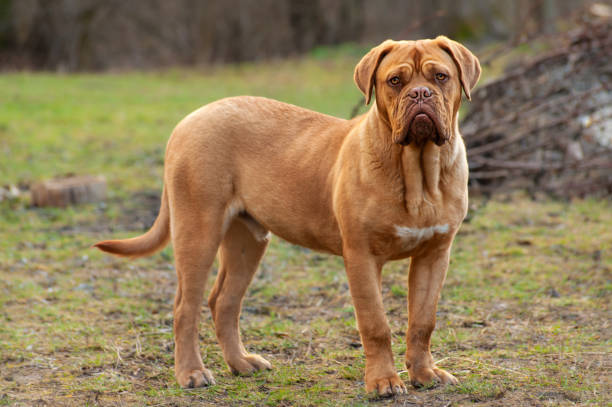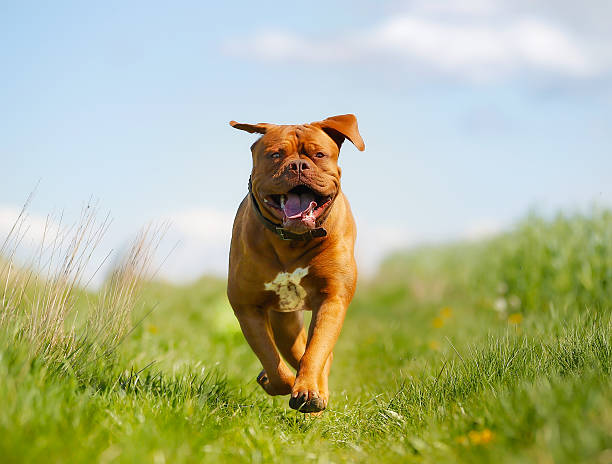French Mastiff (Dogue de Bordeaux)

Breed History:
The French Mastiff, known as the Dogue de Bordeaux, is one of the most ancient dog breeds in France, with roots dating back to at least the 14th century. Bred in the Bordeaux region, this powerful Molosser-type dog was traditionally used for guarding estates, pulling carts, and even hunting large game such as boars. Over time, it gained a reputation as a fearless guardian, loyal to its master and protective of its territory.
The breed’s popularity waned and resurged several times, especially after near-extinction during World War II. It gained international fame after appearing in the 1989 film Turner & Hooch, where a Dogue de Bordeaux starred alongside Tom Hanks, introducing the breed to global audiences.
|
Gender |
Height |
Weight |
|
Male |
60–68 cm |
54–65 kg |
|
Female |
58–66 cm |
45–54 kg |
Size – Large
Life Expectancy: 5–8 years

Breed Appearance:
The Dogue de Bordeaux is a muscular, thick-set breed with a powerful frame and imposing presence. It has a massive, broad head—one of the largest in the canine world—with deep facial wrinkles and a pronounced stop. The short, soft coat is fine and comes in various shades of fawn, often accompanied by a black or brown mask.
Its eyes are expressive and slightly oval, and the ears are small, set high, and fall close to the cheeks. The tail is thick at the base and tapers to a point, carried low. Despite its bulk, the breed moves with surprising agility and purpose.
Breed Type – Guardian/Family Companion:
Originally bred as a working and guardian dog, the Dogue de Bordeaux retains a strong instinct to protect. It is calm, confident, and incredibly devoted to its family, often forming strong bonds with all members of the household. Despite its intimidating appearance, it is known for being affectionate and gentle, especially with children.
The breed is naturally wary of strangers and has a protective streak, making early socialisation essential to balance its territorial instincts. It is best suited to experienced dog owners who can manage a strong-willed, powerful companion.

Training:
The Dogue de Bordeaux is intelligent but has an independent, sometimes stubborn nature. Consistent, patient, and confident training from an early age is crucial. Positive reinforcement works best, as the breed does not respond well to harsh or punitive methods.
Socialisation from a young age helps prevent overprotectiveness and ensures the dog grows into a stable, well-mannered adult. Due to its strength, leash training and obedience should be prioritised early. While it may not be as eager to please as some breeds, with the right motivation and respect, the Dogue de Bordeaux can learn well.
Health & Care:
Like many large breeds, the Dogue de Bordeaux is prone to certain health conditions, most notably:
-
Hip and elbow dysplasia
-
Heart problems, such as aortic stenosis
-
Bloat (gastric torsion)
-
Skin infections in facial wrinkles
-
Shortened lifespan, often under 10 years
Due to its large size, joint and cardiac health should be monitored closely with regular vet visits. Maintaining a healthy weight and eating in smaller, frequent meals helps reduce the risk of bloat. Owners should also clean skin folds regularly to prevent irritation and infection.

Living Conditions:
Though large, the Dogue de Bordeaux is relatively calm indoors and can adapt to apartment living if provided enough space to move comfortably and access to regular outdoor exercise. It prefers a quiet, structured environment and thrives when it’s close to its family.
Because of its protective nature, a securely fenced yard is important if the dog is allowed outside. This breed does not tolerate extreme heat well due to its short muzzle and heavy build, so shade and hydration are crucial during warmer months.
Exercise:
Despite its size, the Dogue de Bordeaux has moderate exercise needs. Daily walks and light play sessions help maintain muscle tone and mental stimulation, but it should not be overexerted, especially when young, to avoid stress on developing joints.
It enjoys interactive time with its family but isn’t a high-energy dog. Avoid strenuous activities during hot weather, and never force exercise. Controlled movement and short bursts of activity are ideal.
Grooming:
The Dogue de Bordeaux has a short, soft coat that is easy to maintain. Weekly brushing helps remove loose hair and promotes healthy skin. However, its facial wrinkles require special care—these folds should be cleaned and dried regularly to prevent irritation and infections.
Regular ear cleaning, nail trimming, and dental care are essential. The breed may drool significantly, so keeping a towel handy is recommended, especially after meals or drinks.

Advantages:
-
Loyal and protective—an excellent family guardian
-
Calm and affectionate with loved ones, including children
-
Minimal grooming requirements for the coat
-
Low activity indoors—suitable for homes with limited space
-
Strong deterrent presence due to size and bark
Disadvantages:
-
Short lifespan and prone to serious health issues
-
Requires firm, experienced handling and early socialisation
-
Can be stubborn and dominant if not trained properly
-
Sensitive to heat and requires careful exercise management
-
Facial folds require frequent cleaning to prevent infections
-
Can drool excessively, especially after eating or drinking









